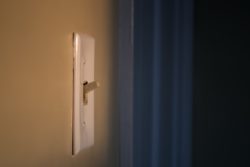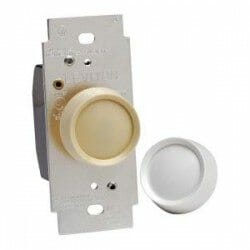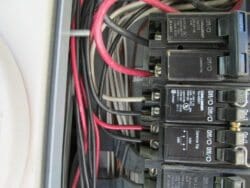Light Switches Warm or Hot to the Touch
Home » Electrical » Switches »
Light switches and especially dimmer switches or other custom light switches often feel warm to the touch after they have been on for some time. A warm light switch can be normal, however if the switch is hot then it should be investigated as it is a fire concern.
Common reasons a light switch is getting hot
The main reasons that a light switch may be getting too hot are:
- Poor installation, terminals or wire connections are loose causing arcing
- The light switch is rated for a lower amperage than the circuit it is installed on
- The switch is cheap and of low quality
- The switch is worn out and damaged
How hot is acceptable for a light switch?

A good rule of thumb is that if you cant hold your finger on the switch for more than a few seconds – it is probably too hot. Most switches actually have a specific maximum temperature which they are allowed to operate. The absolute maximum of most dimmer switches is 195F however most switches operate lower than 140F.
Overtime increased heat in a switch can cause the wire’s insulation to become brittle and eventually crack or fall off. Non insulated wiring can cause arcing, short circuits and eventually fire. Many switches are rated for 15amp lighting circuits but often get installed in 20amp circuits. This doesn’t mean that the switch will be subject to a full 20amp’s it just means that it is possible for the switch to be subjected to 20amps of electricity if there are enough power drawing devices to require that much electricity on the circuit.
15amp circuit lighting capacity
Most light bulbs are measured in terms of how many watts they consume to provide light. The formula for calculating how many watts are available in a circuit is actually very simple! Take the total amperage of the circuit (as seen on the breaker) and multiple it by the voltage. A typical voltage seen in the United States is 110, 115 or 120 volts. Lets take 120 volts x 15 amps and we get 1800 watts.
Theoretically you could run 18 100watt bulbs on that circuit however most electricians recommend only using up 80% of the capacity. In that case you could have about 14 100watt bulbs on the circuit, assuming of course there is nothing else connected to that circuit.
Sometimes people will install receptacles on their switched lighting circuits so that they have an outlet in a convenient place. If they then run a vacuum, hairdryer or other device it could cause the breaker to either trip (as its exceeded the 15amps) or to operate closer to 100% of the capacity of the circuit which keeps the switch fully loaded.
20amp circuit lighting capacity
We will again take the total amperage of the circuit multiplied by the voltage (assuming 120volts) and we would get 2400watts of capacity. Reducing this number by 20% as a factor of safety, you would be 1920watts. You could use 19 100watt bulbs assuming nothing else was running on that circuit!
Dimmer Switches

A dimmer switch often feels warm to the touch especially on the face plate. The way that dimmer switches work results in some heat being generated and this is normal as long as you can hold your hand on it comfortably. In order to reduce the electricity flowing to the lights and thus dimming them – the excess electricity must go somewhere and it is dissipated as heat through the switch itself.
One common problem occurs in a remodel where additional lights are added to a dimmer switch circuit resulting in a larger draw to the switch. When adding new lights to a circuit, the switch must be checked to make sure that it can handle the additional load.
An easy solution if the circuit is not the problem is to simply upgrade the dimmer switch to one that can tolerate a higher wattage such as 1500watts. If there are many traditional bulbs on the circuit, switching to LED lights can reduce the wattage significantly – in some cases by 80%.
Traditional Switches
If a traditional on/off light switch feels hot it is definitely a cause for concern as these types of switches do not dissipate heat as a means of reducing the current to the light bulbs. The most common reason again is improper wiring, loose wires, worn out switch components, or more electricity flowing through the switch than it was designed for.
Who to consult?
Electrician’s are the best to consult about warm and hot switches. Replacements, if necessary can easily be done by electricians or qualified handymen.


